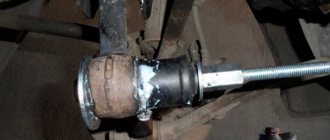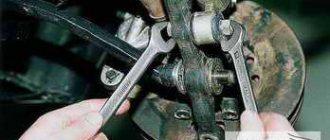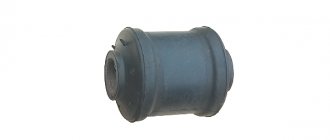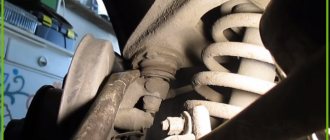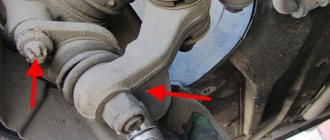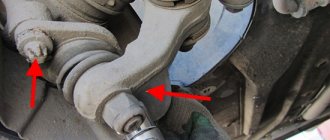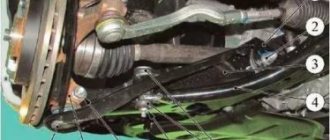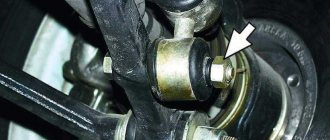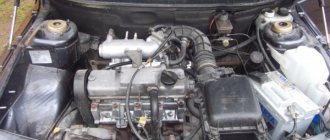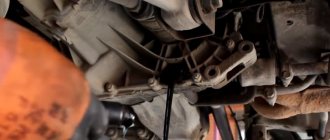The most common car brand on the roads of our country is definitely everyone’s favorite VAZ. The “ten” generation is especially widespread, being the standard of budget cars. Like any mechanism, VAZ cars break down periodically and require repairs. Due to the poor condition of Russian roads, the car's suspension suffers the most, in which the greater impact falls on connecting elements such as silent blocks.
The process of replacing silent blocks
To replace the silent blocks of the lower control arms on VAZ classic cars, you need to drive the car into a garage or pit box, or use a lift. The fastening points of the parts are pre-treated with WD-40 lubricant, which must be left for a while to facilitate the removal of these parts. When processing, you need to make sure that the lubricant gets into the attachment points of the unit, this will make dismantling easier. During operation, the silent block may sour, and if it is not treated in advance, it will be difficult to remove it using a pry bar and a sledgehammer.
If the car is parked in a pit, it is jacked up under the beam to relieve the load from the wheels, supports are placed under the levers, and a safety block is installed under the jack to avoid injury in the event of the car falling off the supports under the levers. Using a 22 wrench, unscrew the nut holding the silent block in the lower arm. If the nut is soured, you can use a piece of pipe as an additional lever by placing it on the wrench. It is better not to throw away the original nuts, since new ones are often of poor quality and the threads break off, so sometimes it is better to install old ones. The same can be said about old washers, which are made of thick, durable metal, while the washers that come with new silent blocks are thinner and can be significantly deformed when tightened, which is unacceptable.
To dismantle the front silent block, the mount must be positioned so as to rest against the bolt of the beam and press forward towards the rear of the car. Since the pressing force on the mount will be small, it is necessary to periodically hit the lever near the silent block with a hammer, while pushing against it to create tension. After the silent block comes out of the socket, remove it, pushing it with a pry bar. In case of severe souring, the procedure will have to be done by two people: one person pulls the lever with a pry bar, the second knocks the silent block out of its socket.
Next, the silent block of the front beam is replaced; for this, the axle is lubricated with nigrol and a new part is put on it. Using a pry bar, the lever is raised so that the silent block can be guided into the socket. After this, an extension made of a thick-walled pipe of suitable size is put on it, which must be carefully hit with a hammer until the silent block sits in place. We hold the mount by the mounting bolt and press the lever, continuing to hit the mount with a sledgehammer until the part sits in the socket all the way to the stops.
We change the lower silent blocks from the reverse side, for which you first need to knock the short rod end off the steering column so that it does not interfere with work. Using a pry bar, pressing it against the nut, we move the lever in the same way to release the silent block. Similarly, we hit the lever with a hammer, pulling it with a pry bar until the silent block comes out of its socket, then push it with a pry bar until it is completely removed. Installation of a new silent block is carried out in the same way as in the front part of the lever, using an attachment made from a tube and a hammer, the axle and seat are pre-lubricated with nigrol.
Washers are placed on both silent blocks; if the old ones are in good condition and not deformed, it is better to install them, since the new ones are of very poor quality, they bend when the nuts are tightened, reducing the service life of the parts. After the nuts are tightened on both sides, the car is lowered from the jacks and needs to be rocked to check how the suspension works. In this case, the creaking and knocking should stop, and the suspension operation should return to normal.
When tightening the silent block nuts, it is better to load the front of the car, first on one side and then on the other, for which you will again need a partner. If it is not there, you can tighten it like that, but then the nuts will need to be tightened again. The nuts are tightened as tightly as possible; if necessary, a pipe is put on the wrench to develop maximum force. At the same time, the threads on low-quality nuts can be stripped. At the end of the work, you need to reinstall the previously removed steering rod.
Video: How to replace the silent blocks of the lower arms of a VAZ without a puller.
This method is quite labor-intensive, but does not require special tools such as a puller, or additional knowledge and skills. You can make the replacement yourself in your garage if it has a hole. In this case, you can use a simple tool that every driver has. The quality of work will be in no way inferior to replacement using a specialized puller. The shock absorber silent block and other similar parts are replaced using similar principles. This technique is suitable for VAZ classic series 2101-2107.
Replacing lower arm joints
Replacing the lower front suspension arm on VAZ 2107 cars.
When you finish with the upper one, you can proceed to the lower one. His fastening is done a little differently. And the replacement of VAZ-2106 silent blocks is carried out without removing the suspension arm. You just need to unscrew the nut, which, by the way, needs to be replaced with a new one during assembly. And remove the washer. That's all, now use the hollow bolt of the puller to press out the hinge. The second one is extracted using the same exact technology.
Installation of new hinges is done by pressing. To do this, a silent block is inserted into the hole by hand. Then, using a stand, carefully strike with a hammer. You don’t need to hit with all your might, a sharp but weak blow is enough. But this is if there is no puller, and if there is one, then the task is simplified many times - place it on the hinge and slowly, avoiding distortions, screw in the bolt. After pressing, check that there is no gap. When finished, screw in a new nut, not forgetting the washer. That's all, the replacement of the VAZ-2106 silent blocks is completed, you can put the upper arm in place.
The silent block is an important part of the suspension, which ensures the mobility of the elements relative to each other, and also eliminates friction from metal parts. If so, it needs to be changed. On all VAZ classic models (2101, 2102, 2103, 2104, 2105, 2106 and 2107), the silent blocks of the front levers change in the same way. The procedure for replacing the silent block of the VAZ upper arm is as follows: 1. Jack up the car and remove the front wheel.2. Unscrew the nut on the axis of the upper arm (you need a 24mm wrench).
3. Using the same 24mm wrench, unscrew the nut on the upper ball joint, then use a puller to unpress the support pin (instead of a puller, you can use two 13mm wrenches to unscrew the support).
4. Tighten the steering tip nut and unpress it.
5. Unscrew the nut of the upper arm axle, and then remove the axle. On VAZ 2104, 2105 or 2107 cars, this will also require unscrewing the vertically located bolt that secures the bumper.
6. Holding the lever in a vice, press out and replace the silent blocks of the upper lever using a special tool.
7. Lubricate the axis of the upper lever, then put the lever in place. Do not tighten the axle nut completely.
8. Assemble the support in the reverse order, tighten the wheel, lower the car, and then tighten the axle nut completely. After this, you can begin replacing the silent block of the lower arm: 1. Unscrew the nuts of the lower arm axle (you need a 22mm wrench).
2. Using a puller, squeeze out the silent block
Please note that the tie rod end may need to be removed to install the puller. 3
Remove the silent block, lubricate the axle with oil, and then insert a new silent block
3. Remove the silent block, lubricate the axle with oil, and then insert a new silent block.
4
Insert a stop bracket between the arm and the nut that secures the lower arm axle to the beam. 5. Press in the silent block, then install and pin the steering ends.
6. Assembly is carried out in reverse order.
Car silent blocks require monitoring and timely replacement. The service life of the silent block is up to 100,000 km
mileage, but Russian conditions dictate their own rules, it has to be done
every 50,000 km
.
Broken silent blocks of the front suspension arms on VAZ-2110 vehicles are indicated by a characteristic knocking or grinding sound that is heard when the car is moving. The car not only begins to rattle, but also loses stability on the road and becomes more difficult to control. It happens that when a car undergoes a wheel alignment, it is discovered that the silent blocks are faulty.
It is quite possible to change the silent blocks of a VAZ 2110 with your own hands. Of course, you will have to get dirty and spend several hours of your time to repair the car. The same procedure for replacing a set of silent blocks at a service station will cost 1100-1400 rubles
. You can decide whether to take on the work yourself or entrust it to others after viewing this photo report.
It is worth noting that the photo instructions are based on the experience of car enthusiasts and contain tips for drivers with a minimum set of necessary tools. In the repair instructions you can find another solution to this problem.
How difficult is the job?
Any novice craftsman can cope with such repairs; the silent block of the grant will be shown in the photo; it is not difficult at all. It is worth doing the work in the following sequence. You need to hold the stretcher with one key, and use the second to unscrew the nut. Now you need to unscrew the 3 bolts that secure the crab, after which replacing the silent blocks of the fret grant involves removing the brace.
The attractive price for the grant silent block will allow you to purchase parts without extra costs. When you try to remove the stretcher, the rubber part may fall out towards you
Please note that the part also has metal clips; you will also have to deal with them. To do this, you can use a screwdriver and a hammer, or take a drift; the work can be seen on replacing silent blocks on the video grant
How does a malfunction of the front silent blocks manifest itself?
It's easy to find out if they're working correctly.
To do this, you need to pay attention to the following:
- Will the rubber of the front wheels stick together while driving? However, driving does not have to be long distances. Even when traveling short distances, creaking should not be observed. This does not mean that the creaking will be very noticeable - it may be barely audible;
- Are there any defects on the tires? Usually, if silent blocks do not work well, then small cracks and breaks appear on them.
- Is there any knocking noise in the front wheels? The fact is that the silent blocks begin to slide poorly, so over time it becomes more and more difficult for them to spin, which is why they begin to make sounds similar to knocking.
Preparing to replace them
The vast majority of people are afraid to spend time at home. Although in reality this is a fairly simple task. But first you need to prepare properly. A puller is a must. With its help, it will be possible not only to remove the silent blocks, but also to return them to their original position after performing all the maneuvers. What is a puller? This is a tool consisting of two tubes and two washers.
How to make a puller
The most suitable puller option is a three-jaw puller. To create it you need to have the following materials:
- Sheet metal 10 mm thick.
- Metal round timber with a diameter of 30 mm.
- Screw.
You can easily make a puller if you follow the instructions:
- Draw a drawing of the puller's legs. Their length should be approximately 20 cm.
- Apply the pattern to sheet metal.
- Cut out the legs and sand them.
- At the top of the legs you need to drill 2 holes for the bolts.
- Next, you need to make a core, for which you will need prepared metal round timber. You need to drill a hole for the thread. Weld two leg holders (6 in total).
- The last part is the screw. Holes should be drilled through the top of the screw.
- All that remains is to assemble the puller. To do this, you need to insert the screw into the core and attach the legs to it.
Replacing the silent blocks of the upper arm
Replacing them involves the following steps:
- Raise the car on a jack and secure it.
- Remove the front wheel.
- Remove the upper arm. However, before doing this, you need to carefully look to see if the silent blocks in the lever are slipping. They must be stationary.
To make it easier to remove the upper arm, you need to knock out the upper support. To do this, unscrew the support nut.
- This bolt needs to be pulled out, which will allow you to remove the machine arm.
- You can start replacing them.
- You can remove the silent blocks using a hammer or chisel. In fact, they fall out almost after the first hit. The main thing is not to damage the car.
- Now you need to insert the new silent block where the old one was. You need to press it in properly so that it does not dangle. You can press it in easily: one bushing fits the size of the silent block skirt, the other is a little larger. By pressing with the smaller bushing, it easily fits into the lever.
Repair of axial play
There are two repair options:
- Replace the entire pole completely. However, not only is it very expensive, but its quality is not the best.
- You can tighten two washers on the sides so that the bolt cannot dangle.
Replacing the lower arm silent block
The lower silent blocks are a little more difficult to replace:
- First you need to remove the stabilizer, which will allow you to move the lever left and right.
- Now you need to unscrew all the nuts that hold the silent block stationary.
- You need to remove the lower control arm silent blocks. To do this, you need to repeat all the steps as with the silent blocks of the upper arm.
- Now you can start pressing in new silent blocks.
High-quality photos, a corresponding video or instructions will help everyone complete the work of replacing the front silent block with their own hands. However, you need to be extremely careful, because you can do a lot of damage to your car. This will lead to you having to pay double for your stinginess. But the price of “home” repairs is lower than in a car service.
The car structure includes many components
An important component of any car is the suspension. It is she who is responsible for the comfort and safety of the car.
But if you think that only the wheels, shock absorbers or springs affect the softness of the suspension, you are deeply mistaken. Do not forget about such a component as silent blocks. Any car is equipped with these, including the VAZ-2110. Replacing silent blocks is not an easy process. However, you can do it yourself. Well, let's look at how to replace the silent blocks of a VAZ-2110 beam and what is needed for this.
Installing rear independent suspension on a car
When operating a vehicle on which a standard rear suspension is installed, the vehicle beam shifts towards the arch when cornering by approximately 1 cm. If the vehicle is equipped with a rear independent suspension, then such a beam displacement is not observed under similar operating conditions. The rear independent suspension is attached rigidly to the body, without using silent blocks in mounting the rear suspension on the Priora, which avoids lateral displacement of the beam.
Silent blocks, which are part of the design of the rear and front suspensions, perform the function of damping all torques and bending moments that may occur during movement, thereby ensuring a stable position of the vehicle on uneven road surfaces and when turning.
Silent blocks are mounted on a car as an element of the chassis and suspension, since this structural element is one of the most reliable and economical ways to prevent the influence of various types of deformations and loads that can occur during the operation of the car on the car body. Installation and replacement of silent blocks on Priora is provided for in some vehicle suspension components:
How to know when it's time to change
There are several signs that the silent blocks have become unusable.
- The first sign is a characteristic knocking or grinding noise that is heard when the car is moving and which intensifies significantly when the road is uneven.
- The second sign is that if one or more silent blocks are broken, then the car becomes much more difficult to control, especially when turning.
- Even if none of the above is observed, a problem with silent blocks can still emerge, for example, at the moment when the car owner arrives at a car service center and decides to adjust the wheel alignment. It is at this moment that service employees can tell him unpleasant news.
Selection of parts and necessary tools
Before you start directly replacing silent blocks, it is important to properly prepare for it. There are few specific recommendations for choosing new parts. The auto parts market is simply filled with silent blocks from different manufacturers, basically they are all quite good
The only thing you can do to make a better choice of new parts is to consult with auto mechanics in your area. The main thing is that the new vibration isolators fully fit
The auto parts market is simply filled with silent blocks from different manufacturers, mostly they are all quite good. The only thing you can do to make a better choice of new parts is to consult with auto mechanics in your area. The main thing is that the new vibration isolators fit completely.
For repair work you will need the following things:
Set of new silent blocks
Replacing suspension silent blocks with your own hands
The suspension silent blocks on the VAZ-2112 are located in the arms of both the rear beam and the front one. It is advisable to replace them comprehensively. The replacement process is approximately the same on both the rear and front parts of the suspension. Below are instructions for both cases.
Front control arms
Replacing front control arm silent blocks on a VAZ-2112 is the following process:
- First of all, the car must be placed above the inspection hole or use a lift. Then remove the engine compartment protection represented by the casing.
Removing the engine protection
Unscrew the nut of the stabilizer bar mounting bolt.
Unscrew the nut on the extension
Unscrew the nut of the bolt securing the lever to the body
A long bolt, a couple of washers and a nut are all sold in hardware stores and can be used to make a puller
“Let’s spritz”, it’s better to heat it up some more. Next, we use our puller to press out the silent block.
We clean the socket from rust and dirt, lubricate
We press new silent blocks into the mounting groove
New silent block installed
Replacing silent blocks in the rear beam
Replacing the rear silent blocks is done as follows:
- Again, the car must be driven into a viewing hole or raised on a lift.
- Then, taking a 19mm wrench, you need to disconnect the rear beam from the bracket by unscrewing the nuts securing it.
Unscrew the nut of the bolt securing the lever to the bracket
Press the silent block towards the car threshold
Press in the silent block using a puller
Beam structure
On the inside, brackets with special holes necessary for installing shock absorbers are attached to the suspension arms. There are also flanges located there, bolted to the axle of the rear wheels and shields located on the brake mechanism. Bushings are attached to the suspension arms on the front side. They are inserted into hinges made of a special rubber-metal material.
Bolts pass through them, connecting the suspension arms together with the stamped-welded brackets. They, in turn, are attached with bolts welded into the side member of the car. The springs of the rear beam of the VAZ 2110 are located in such a way that the first end rests against the recess of the shock absorber, and the second passes through a special gasket directly into the support area attached to the underside of the arch on the car body.
The gasket acts as an insulator and is made of rubber. The shock absorber mounted on the rear suspension is double-acting. It is attached with short bolts directly to a bracket located on the trailing arm in the rear suspension area. In the upper part, fastening is done using the rod method. The rod is fixed in the upper support directly on the suspension spring. The shock absorber is fixed through a protective rubber pad and a support washer.
A double row thrust bearing is located in the middle of the hub. Its structure is very similar to the bearing located in the hub of the front wheels, but it is much smaller in size.
When is it necessary to replace silent blocks?
If you hear a distinct knocking sound in the suspension while driving, you may need to replace the silent blocks of the front control arms on VAZ classic models. Upon inspection, they may be deformed, the rubber is torn or covered with deep cracks, and the lever moves from its original position. Silent blocks are not repaired; if they fail, they must be replaced, fortunately they are not expensive.
Damage to the silent blocks makes the ride less comfortable, reduces the level of safety due to deterioration in handling, as play appears on the arms, the suspension becomes looser and the wear of the front tires sharply increases, and this is another signal that the silent blocks of the front suspension will need to be replaced.
Why do the rear beam silent blocks fail?
During operation, the rubber part peels off from the metal bushing.
The rubber of the parts itself, which is cast with metal bushings, must withstand enormous loads, but time destroys the rubber.
In addition, if the parts are installed skewed, or the quality of the ohms turns out to be low, which often happens, then the silent blocks can quickly fail. In addition, the following factors affect the durability of parts:
- The main factor that affects the service life of obviously high-quality silent blocks is driving style. If you do not pay attention to holes and other irregularities, then they will be the first to suffer in the suspension.
- Wheel alignment also affects the life of the hinges. If this is not done periodically, the wheel alignment angles will change, which will lead to incorrect operation of the suspension.
- Rubber is not very durable, especially if oil and other technical liquids get on its surface. In these cases, the surface of the silent compounds becomes covered with cracks, which can lead to ruptures.
In order to avoid problems and expensive suspension repairs, it is recommended to inspect the condition of the silent blocks at least once every six months. This will help to identify and eliminate problems in a timely manner.
What to consider when replacing
The silent blocks of the VAZ-2108 and VAZ-2110 visually seem exactly the same, but in fact their mounting dimensions are different.
There are several secrets and recommendations, taking into account which you can achieve more durable operation of the rear suspension hinges:
- You should not try to install silent blocks from the “nine” on a VAZ-2110. Although they are almost identical in appearance, the “nine” spare part is a couple of millimeters smaller. Therefore, setting this element to “ten” is unacceptable. But the opposite can be done by applying a little more effort when pressing.
- Scheduled replacement of rubber suspension joints should be carried out no less than after 40–50,000 km.
- If one silent block fails, it is better to change the others that are located next to it. This will save the owner from repeated repairs, the need for which may arise after several thousand km.
High-quality repair of the rear suspension on a VAZ-2110 depends on the skills of the car owner. At the same time, it is quite simple. It is enough to do it yourself once to acquire the necessary skills. In order for everything to work out right the first time, it is recommended to involve more experienced colleagues in the work for the first time.
Repairing the suspension yourself, or contacting a specialized service station is everyone’s personal choice. If you decide to entrust the work to specialists, it is better to control the entire process yourself, so that next time you can do everything yourself.
How many silent blocks are there in the rear suspension?
The suspension in a car is needed to ensure a movable connection between the wheels and the body. At the same time, it must absorb as much as possible the unevenness of the road and the vibrations of the car that occur when driving on a bad road. The suspension is part of the chassis of the car. Not only the driver’s feeling of driving on the road depends on the condition of the suspension, but also safety, i.e. vehicle stability when driving at high speed. The suspension can be front or rear, and include many different elements depending on the model of a particular car. One of the most important connecting links in a car’s suspension is the silent block. This is what we will talk about in today’s article.
Chassis elements
A car suspension is a complex system of many elements. Generally speaking, they can be divided into three groups:
· Guides;
· Elastic;
· Extinguishing.
The former ensure that the suspension is attached to the body and forces are transferred to the car body. The guide elements are also responsible for the movement of the wheels relative to the vehicle body when it moves. A variety of levers are used as guides: longitudinal, transverse, and so on.
An elastic suspension element absorbs loads from road unevenness, accumulates the resulting energy, and transmits vibrations to the body. In modern cars they are presented in the form of springs, leaf springs, and torsion bars. The last part, called the shock absorber, is designed to reduce the amplitude of vibrations of the car body. The operation of shock absorbers is based on the resistance that occurs when fluid flows between the two cavities of the shock absorber cylinder.
What is a silent block?
Upon closer examination of this element, it becomes clear that the silent block is a rubber-metal hinge that has one or more metal bushings surrounded by rubber. It is necessary to connect the suspension parts together, while the rubber silent block is necessary to dampen vibrations between the units that it fastens. Silent blocks are used both in the front suspension, in particular for attaching arms to the body, anti-roll bar, and in the rear suspension. Often used for fastening gearboxes and other machine components and mechanisms.
How to check silent blocks
As a rule, good quality original spare parts can last more than 100 thousand kilometers. However, taking into account the peculiarities of our climate and roads, control inspections should be carried out somewhat more often, once every 50 thousand kilometers. In addition, you can also understand that the silent block has worn out by your own feelings, control deteriorates, and knocking appears in the chassis when driving.
However, the best way to determine the failure of silent blocks is visually. To do this, you need to drive into a pit, or lift the car on a lift. There should be no cracks or tears in the rubber part of this chassis element, and the bushing should be level and not skewed. Failure of silent blocks primarily affects wheel alignment/camber, because when they break, the levers take the wrong position.
How many silent blocks are there in the rear suspension?
When planning chassis repairs, each car owner calculates what spare parts he will need. At the same time, replacing silent blocks is a procedure that cannot be avoided, so they must be purchased in advance. Here the car enthusiast is faced with the question of how many silent blocks are in the rear suspension of a Lancer 9, Mazda 6, VAZ 2109, Opel Vectra S, Ford Focus or any other car he owns? Let's take the above options as an example
Automobile
| Number of silent blocks in the rear suspension | |
| Mitsubishi Lancer 9 | 14 |
| Geely CK | 12 |
| Mazda 6 | 14 |
| Opel Vectra C | 14 |
| VAZ 2109 | 4 |
| Ford Focus 2 | 14 |
bibioil.com
Silent blocks: purpose and condition diagnosis
Silent blocks are vibration-isolating parts used in the suspension structure of any modern car . Such vibration isolators consist of metal and rubber (elastomer). Thanks to the use of vulcanized processing technology, silent blocks are excellent dampers and insulators from external vibrations received by the machine when moving.
These parts, familiar to every car enthusiast, need to be changed from time to time. Therefore, our resource decided to highlight in today’s material the question of how to replace VAZ-2112 silent blocks with your own hands. Having familiarized yourself with it, the repair process itself and preparation for it will become a fairly simple task for you.
The main function of these parts is to connect the suspension units in which torsional, radial and axial vibrations are the strongest, and subsequently dampen them.
Thus, silent blocks provide not only comfort when driving a car, but also increase the service life of some other suspension parts for a considerable period.
Lifetime
On average, manufacturers of silent blocks set their service life to 100,000 kilometers. But, as noted earlier, due to the not very good condition of Russian roads, vibration isolators often wear out ahead of time. Many auto mechanics advise checking the condition of the VAZ-2112 suspension silent blocks every 15-20,000 kilometers , and replacing them every 60-80,000 .
In any case, you can finally make sure that parts require replacement only by inspecting them. This can be done at a service station by lifting the car using a lift, or by using an inspection pit.
The most difficult option is to dismantle all the levers or beams and check the silent blocks directly on them. If there are noticeable defects on the vibration isolator (severe scratches, chips, cracks, etc.), then they must be replaced.
Symptoms of faulty silent blocks
Worn silent blocks
In addition to all this, the behavior of the car while driving , or more precisely:
- spontaneous pulls of the car to the side;
- “dull” sounds (knocking, grinding) from under the car;
- the appearance of difficulties in driving your VAZ-2112, that is, a sluggish reaction to turning the steering wheel.
Important! All of the above is complemented by the inability to set the normal wheel angle during a wheel alignment event.
How to press out a silent block at home?
Replacing silent blocks is not difficult; for example, I personally became convinced of this when I replaced the silent blocks and shock absorbers on the rear suspension with my own hands. It is for this reason that you can often meet those who decide to independently replace silent blocks at home.
Method 1
First, let's talk about how this should ideally happen. The lever in which it is necessary to replace the silent block is taken, installed under the press on a special stand into which the old silent will be squeezed out, after which a special spacer is installed on top, which will squeeze out the old bushing. This method is used by service stations that have the necessary set of spacers and a powerful press of 10-20 tons.
Method 2
Most motorists, of course, do not have a powerful press, but many have a good vice or jack in the garage. Using a powerful vice, you can successfully squeeze out old bushings using a similar principle - a spacer into which the bushing will go and a spacer that will press on the bushing.
Jack. It would seem, how can a silent block be squeezed out with a jack? Everything is very simple, you need to weld a rectangular frame from some channel or corner at a height slightly higher than your jack and lever. The principle is as follows: we install the jack in the frame, after which we install the lever eye and the two spacers mentioned above on top of the rod. We create the necessary pressure, and the bushing is squeezed out of the seat. It should be noted that in most cases, a 3-5 ton jack is simply not able to cope with such work, so it is better to use 10-15 ton jacks.
Method 3
If you don’t have a jack or a press, and you have an insatiable desire to replace the silent blocks yourself, you can use the third method - using a simple press puller (a pin or a bolt with a nut). The principle is to create pressure by gradually tightening the nut on the stud; this method can be considered analogous to a vice. A pin with a washer of the required diameter is inserted into the eye through the silent block, then a spacer with a washer is put on the other side and the nut is tightened. Rotating along the thread, the nut creates the necessary pressure and forces the silent block to be squeezed into the “receiving” spacer. This “method” requires a strong, hardened stud with the same nut. If the nut or stud is soft, you won't succeed. For example, my pin began to bend due to pressure, after which the thread on the nut was torn off. However, there are thousands of those who managed to replace silent blocks using this particular method. The advantage of this method is its cost-effectiveness and convenience from the point of view of “mobility”, that is, you do not need, for example, to completely remove the entire hub or lever, you just need to have such a primitive press puller.
How to press out/press in a silent block using a press puller video
Method 4
This method can be classified as drastic or extreme measures. It consists in using all known methods and devices to extract the silent block from the mounting socket. The principle is to knock out the old silent block using a powerful screwdriver or a thick wedge-shaped piece of reinforcement. The task is to drive a screwdriver or something similar between the bushing and the silent block, thereby deforming the wall of the bushing inward. After the sleeve is crushed and fed inward, knocking it out is not difficult. Before you start knocking out the silent block, you need to burn out or squeeze out the inner bushing of the silent block and, if possible, any remaining rubber.
How to knock out a silent block using a screwdriver and drill
Method 5
The next method of removing a silent block cannot be called pressing out, since it, like the previous one, does not require the presence of a press; all that is needed is a metal blade, a screwdriver and a hammer. The principle is simple, but not safe. We remove the inner sleeve, then take the blade and start cutting the outer sleeve. We are trying to cut through the old silent block as much as possible without damaging the lever itself or the eye. It is advisable to make two cuts, after which using a flat screwdriver, the silent block is easily deformed and knocked out.
If none of the above methods helped you press out the silent blocks, there is only one way out - entrust this procedure to specialists. To do this, we take the part and take it to a service station, where specialists, using special tools, will press out and press in your silent blocks “in the blink of an eye.”
Press-fitting instructions
At the initial stage, it is necessary to visually assess whether the new silent block is suitable for a particular case. This condition must not be neglected, so that later it will not be too late. There are often cases when the outer part fits perfectly, but the inner part does not, and vice versa. Once you determine that the parts will fit exactly, you can proceed to the next step. To do this, you should use a vice to help press it correctly. This method is safer and more accurate.
You can also use hammers and sledgehammers, but you need to be more careful and carefully monitor the accuracy of the process.
Thus, you will need to land several hits. If after this the broken silent block is firmly held in the hole, you need to knock it out. For this work, special mandrels are used for pressing silent blocks or two pieces of pipe. The diameter of one of these parts must correspond to the parameters of the outer joint bushing. When knocking out a part, you do not need to worry about damaging it, since it is faulty. This process is carried out with a regular hammer.
After knocking out is completed, the eyelet in which the hinge was located must be cleaned of dust, dirt, and so on. The seat for the new part must be perfectly smooth and even. There should be no mechanical damage or various scratches on it. In addition, there should also be no sharp edges.
After cleaning the seat, its surface must be treated with lubricant. If this is not available, you can use a regular soap solution. A device such as a metal polyurethane bushing must also be lubricated. Having completed the lubrication of the seat, you can begin to clamp the lever in a vice. In this case, it will be necessary to install a silent block perpendicular to it. This work is done as smoothly as possible. The further normal functioning of your machine depends on this.
Next, you will need to choose how to press in the silent block - press it in or drive it in with a sledgehammer. To reproduce this process, you will need metal tubes or mandrels for pressing silent blocks, one of which will need to hold the lever. And the other tube must be leaned against the side to avoid damage to the hinge when working with a vice or hammer.
The main difficulty with this work may be the difficulty of pressing the hinges into their original place. To perform this procedure, I recommend using a special press to press them in and out with the levers, as well as a mandrel for pressing in the silent blocks. You can also use improvised means, such as pieces of pipe and a sledgehammer, but you should be very vigilant and attentive, since this process requires high precision and dexterity so that the result is a whole polyurethane insert.
You can press in silent blocks with your own hands only on the front and rear parts of the suspension. If you need to replace rubber-metal joints in engine or gearbox components, you should contact a specialist. This is necessary precisely because replacing parts in such units is a labor-intensive process. To implement it correctly, you must have repair experience and a good knowledge of the main components of the car's structure. If you lack experience and knowledge, it is better not to test your luck and entrust your car to specialists. Because, in addition to the time spent, you will spend a lot on replacing silent blocks.
Garage or service station
All car owners can be divided into two categories:
- Those who carry out most of the repairs themselves in their garage, and only in emergency cases turn to a car service;
- Those who prefer not to touch anything with their own hands, but completely entrust repairs and maintenance to the masters of service stations.
Each of them is right in their own way. Therefore, we have no right to reproach those who do not want to carry out repairs themselves. After all, garage and professional repair of silent blocks, like other components, has its advantages.
STO has the following advantages:
- A high-quality, responsible car service provides a guarantee for repairs performed;
- In the event of a repeated breakdown covered by the warranty, repairs will be carried out free of charge;
- Professionals are professionals; they have extensive experience and knowledge, which allows them to competently perform their work.
But first you need to find such a car service, which, alas, is not an easy matter. Many provide a guarantee, but when you re-apply, they do everything possible to prove that the breakdown does not comply with the terms of the guarantee. A banal trick.
Repairing your garage will provide the following advantages:
- Significant financial savings, since you only have to spend money on consumables;
- The quality of the work performed by a master is always in doubt if you do not know this person personally. So self-repair may be much better than at a service station;
- You purchase the silent block, and the master only installs it. Why pay money for work that you can do yourself?!;
- Guarantee that a new one will be installed instead of the old silent block. Questionable service stations can easily install an old, more or less usable silent block instead of the one you gave them. You know what the result is.
Ways to press in silent blocks
There are several options for pressing silent blocks.
Option with a vice
Before pressing the component, it is necessary to clean the seats from rust and burrs with sandpaper. Then lubricate the eyes with Litol lubricant or liquid soap. Place the part on top of the lever, place a special mandrel on it, and use a vice to press the component into the socket.
Pressing using a press
The silent blocks can be pressed in using the press puller that was used to remove the part. You need to select the necessary attachment for pressing, lubricate the eye, install the part correctly and press it, periodically checking so that the component does not go awry.
Press-out device
To make sure that components need to be replaced, you need to do a visual inspection of the rubber parts. They must be intact, without deformation. There should be no play when the car is rocking. When the car is moving, wear will be revealed by the knocking of the suspension, swaying of the body and unstable movement of the car.
To get a silent block at home, you need to:
- Place the lever under the press on the stand where the silent block will go. Place a spacer on top to press out the bushing and press out the part.
- Using a vice instead of a press, you can squeeze out silent blocks using the same method.
- You can use a hydraulic jack. To do this, you will first need to weld a frame from a corner or channel in the form of a rectangle, which is larger in height than the jack. Insert the two spacers listed above and raise the jack until the silent block is pressed into the mandrel. You need to choose a more powerful jack - 10-15 tons, because lifts with 3-5 tons may not help.
- In the absence of special devices, a homemade or factory press puller is used, which squeezes out the part using a bolt, washers, nut and two extensions. All these components must be durable and reliable. Using such a device, you can press out without dismantling the hub and lever.
Using brute force
If you don’t have any of the above devices at hand, you can use an ordinary hammer and screwdriver or some thick sharpened pin to press out the silent blocks. It must be driven between the bushing and the silent block. As a result, the bushing of the part is deformed inward, after which it will be possible to pull out the rubber band and knock out the silent block.
You can press out the part using a metal blade, a screwdriver and a hammer. To do this, you need to remove the inner sleeve and carefully saw through the silent block with a blade so as not to damage the lever. Then use a screwdriver to pull out the part.
To press a silent block using brute force, you need to insert the part into the eye, and hammer it into its seat with a sharp and strong blow of a hammer.
Disadvantages of this method:
- The silent fits crookedly into the eyelet;
- bites the rubber parts of the part;
- The impact may damage the lever or silent block.
After using this method, the component is often damaged and will need to be repressed.
Pressing with the weight of the car
Many motorists press in silent bands with the weight of their own car.
To do this you need:
- Install a screw or hydraulic jack under the vehicle.
- Remove the wheel.
- Install the lever with silent block under the car hub.
- Align the parts well and slowly lower the jack.
Lada Priora Sedan › Logbook › Replacing front suspension silent blocks
When inspecting the car, I noticed cracks on the rubber bushings of the front suspension; the condition was unsatisfactory. The mileage of the car is relatively considerable, so I decided to replace all the rubber joints and bushings in the suspension. And then came the agony of choice, as you always want to do better. The suspension on the Priora, in general, without significant changes, migrated from the VAZ 2108, which weighed noticeably less and had an engine 1.5 times weaker. I wanted to install stiffer bushings. In addition to the original ones, there are a huge number of silent blocks made of polyurethane from different manufacturers. Reviews about them are not always positive, and the price is much higher than rubber ones. In addition, I have the opportunity to compare the operation of identical mechanisms using rubber and polyurethane. Recently, roller bearings with polyurethane tires instead of rubber tires have been used in skip and cage hoisting of mines. As practice has shown, there is no significant increase in the service life of tires, sometimes the polyurethane simply crumbles into pieces. As a result, I did not want to experiment with my own money and bought all the tires produced by Balakovorezinotekhnik.
I don't know about originality. Some of the rubber bands were in boxes with a hologram and the casting looks neater, the rest were simply sold in bulk.
Next I removed the entire suspension.
The daisies on the right lever turned out to be completely broken, the lever was simply hanging on a stretcher, so the car was noticeably thrown into a rut. The balls are in satisfactory condition, they have not been replaced.
Next I started replacing. The easiest way to change is daisies. I first drilled the bushings for attaching the levers to the body and took them out in parts. But pressing the new bushings into place turned out to be a problem. The side of the bushing turns under and the rubber breaks when pressed. I ruined 2 rubber bands like this, I would be very upset if it was polyurethane SS 20 for 500 rubles each. For the future, it is better to make a conical mandrel, on one side with a diameter like the side of the bushing, on the other, like the diameter of the lever hole. As a result, we get the following result.
To press the hinges out of the beam and press in new ones, I made an improvised puller from a piece of pipe, a plate and a long bolt. Everything went well, I didn’t take a photo. I smeared the beam hinges and the attachment of the lever to the body with soap before pressing.
While driving, I saw how a person’s eyes for attaching guy wires to a beam were torn off. I had intact ones, but decided to further strengthen them.
I welded the plates to form a box-shaped profile.
As a result, we have this result.
Also, to increase the caster angle, I removed 2 washers from the left and right braces (2 more remained), according to the repair manual, one washer adds approximately 19′, approximately 38′ of the caster angle was added. There were no problems with replacing the bushings and stabilizer struts. We finally tighten the suspension mounts when the car is installed on the ground and the springs are compressed. The tightening torque of the saber fastening nuts is about 20 kgf*m.
In the end, everything works well, the suspension is assembled, and the car does not roll. The feeling from the increased caster is positive, the car is better stabilized in a straight line and it is easier to control the steering angle. Now I want to remove the rest of the washers, the caster should be about 2°30′, approximately like that of foreign cars. With the power booster, the force on the steering wheel did not increase much.
Removing the rear block
Replacement of the rear beam is carried out after transporting the car to an inspection ditch or lift. To begin, remove the brake pads located at the rear of the VAZ 2110. Disconnect the steel ropes that secure the parking brake to the underside of the beam attached to the rear of the bracket.
Now disconnect the thin brake hoses leading to the brake cylinders located at the rear of the car. Disconnect the brake pipes attached to the beam. In addition, you will need to disconnect the elastic lever from the beam, which is located on the drive responsible for regulating the pressure.
Using a size 17 wrench, unscrew the 4 mounting bolts holding the hub axle together with the rear suspension beam. Remove the axle itself along with the brake mechanism shield and, if necessary, separate them by unscrewing the two fastening screws using a Phillips screwdriver. Bend the bracket and remove the brake pipe.
It is necessary to disconnect the lower ends of the shock absorbers and the nuts attaching the beams to the brackets from the beam. After this, you need to remove the bolts from the beam and carefully remove it. Using a size 17 socket, remove the 3 nuts securing the bracket to the body.
Rear suspension structure: 1 — rubber-metal hinge; 2 — suspension arm mounting bracket; 3 — shock absorber casing; 4 — compression stroke buffer; 5 — casing cover; 6 — support washer; 7 — shock absorber cushion; 8 — spacer sleeve; 9 — shock absorber; 10 - insulating gasket; 11 — rear suspension spring; 12 — lever connector; 13 — rear suspension beam arm; 14 — shock absorber mounting bracket; 15 - flange; 16 — lever bushing
Replacement methods
We will tell you about two main ways to replace silent blocks on the rear beam of the “tens”, which can easily be used in a garage.
Which method to choose is up to you to decide. But before that, familiarize yourself with them in more detail.
First way
The method is not particularly difficult if you strictly follow the instructions. To begin with, we note that the silent block is located at the bottom of the car. Therefore, you will need a jack or inspection hole.
- Raise the car with a jack or drive it into a viewing hole. The second option is more convenient, since this way the view of the bottom will be better. And it’s much more convenient to work standing up than lying under a car.
- It is not necessary to completely remove the rear beam. When dismantling it, you will need to remove additional brake hoses, which takes a lot of time.
- It is better to disconnect the sorcerer so as not to damage it during the repair process. But shoot carefully.
- Now remove the nut with a 19mm wrench. You will have to make a serious effort, which is why some car owners call their comrades for help. If there are no assistants, pre-treat the thread with the almighty WD40 or plain water. This will allow the fastener to oxidize. Then clean it with a wire brush, which will make it easier to remove the element.
- Using a crowbar, lower the beam down a little, but do not remove it completely.
- There is an elastic band on the beam that should be cut off, otherwise it will interfere with the work process. Just keep in mind that if the rubber band is old, feel free to remove it. It is better to dismantle a good product by drilling a small hole.
- Now the silent block is removed.
- The new part is generously lubricated and pressed into its rightful place. Just do not use grease for lubrication, as this substance corrodes the part. The best lubrication option is regular soap or any available detergent.
- Return the sorcerer to its place and tighten the beam.
https://youtube.com/watch?v=nM2tgU95DGo
Second way
The second option for replacing the silent block is even simpler. But he also has his tricks.
- Raise the car on a jack or drive it into a viewing hole.
- Using the same 19 mm wrench, remove the fastening nuts on the rear beam. This will allow you to detach the beam from the bracket.
- Remove the unscrewed bolt and move the rear beam eye down slightly.
- To make work easier, insert a wooden beam between the beam and the body, approximately the same size as a regular building brick.
- Remove the silent block by hitting it with a hammer.
- Lubricate the new block with something slippery, which will allow the element to do its job better.
- Press the silent block into its place.
- Remove the inserted beam and return the beam to its original position, securing it with fasteners.
At this point, the procedure for replacing the silent block of the rear beam of your domestic “ten” produced by AvtoVAZ can be considered complete.
https://youtube.com/watch?v=Xu2_Vq7X7SI
Both methods allow you to independently, without unnecessary problems, resolve the issue of a failed silent block. Just in case, don’t forget to call a friend in the garage who will help you at the most difficult stages.
When should you change?
Usually, the driver will probably guess that the silent block has failed. If a replacement is needed, discomfort while driving will tell you about it. You can feel distinct “iron” impacts and noises in the suspension. But that's not all.
If urgent measures are not taken, the VAZ 2110’s fastenings and connections will break and play will appear. The wheel alignment angles will also suffer, which obviously will not lead to any good.
There are some symptoms to look out for that these rubber parts are worn out:
- When driving, the tires on the wheels squeak. Not necessarily much. There shouldn't even be a slight squeak;
- A knocking sound is heard in the wheel area. The point here is the poor rotation of the collapsing silent blocks;
- As the silent block wears out, it first becomes covered with cracks and then completely falls apart. Here only the deaf can no longer hear the knocks.
Do-it-yourself silent block remover
The VAZ 2107 hinge puller can be purchased ready-made or made by yourself. If you have the right equipment and materials, every car enthusiast can make the tool. It is also worth considering that the quality of purchased devices today leaves much to be desired. You can replace the rubber-metal hinge without special tools, but this will require much more time and effort.
Sequencing
To make a homemade puller you will need the following:
- a piece of water pipe 3 cm long with an internal diameter of 40 mm and an external diameter of 50 mm;
- washer with an outer diameter of at least 50 mm;
- M12 bolt 7 cm long with washers;
- two pieces of pipe 10 cm long and 40 mm in diameter;
- vice;
- hammer;
- lubricant
The puller manufacturing process consists of several stages.
- By striking with a hammer, they ensure that a 40 mm pipe section has an internal diameter of 45 mm, i.e., they try to rivet it. This will allow the lower arm joint to pass freely through the pipe.
In order to drive your car confidently and without accidents, you need to periodically inspect and repair the chassis. Wear of silent blocks affects driving safety, as well as tire wear. To replace damaged hinges, you will need to prepare the necessary tools and perform repairs in accordance with step-by-step instructions.
Selecting New Items
Polyurethane
To replace and ensure reliable operation of the car, you need to purchase good silent blocks. Choosing them is not difficult if you know some nuances:
- For the VAZ 2110 model, elements with catalog number 2110 2914054 are suitable. They have the required outer diameter corresponding to this specific VAZ model;
- Do not try to purchase a silent block from a “nine” and install it on your “ten”. Nothing will come of such events, no matter what anyone says;
- Make sure of the quality of the products. Low-grade silent blocks have flooded the market, but their service life leaves much to be desired. Good parts are made from high quality materials that can withstand extreme loads and temperatures.
